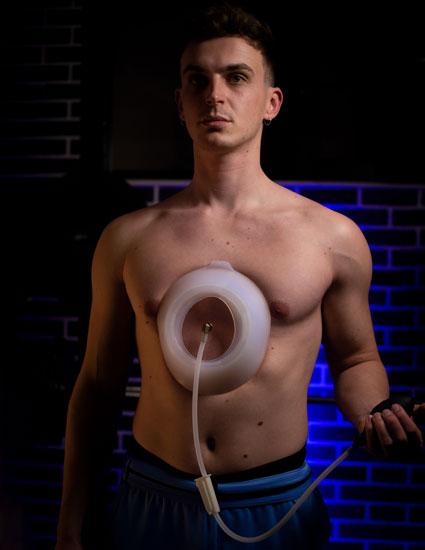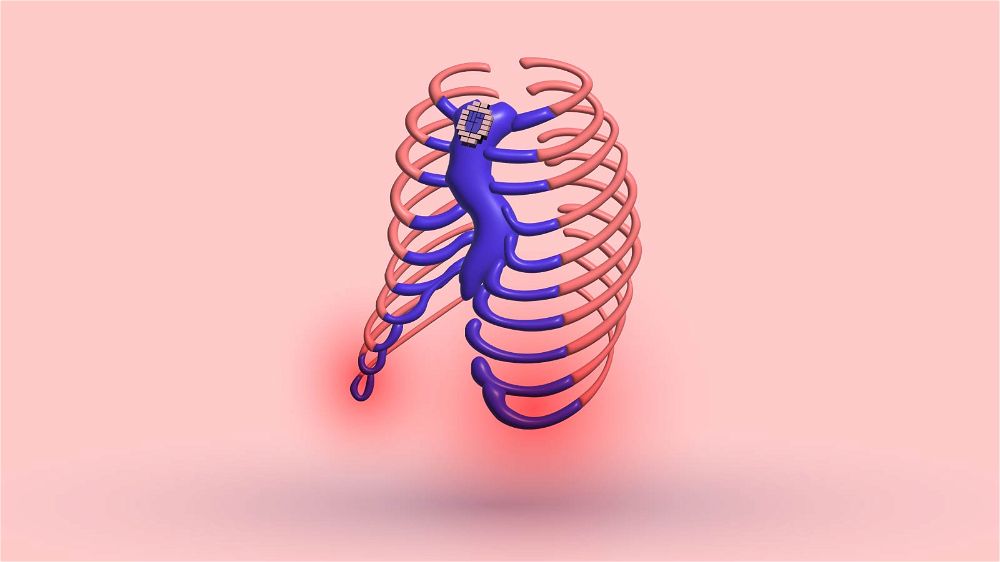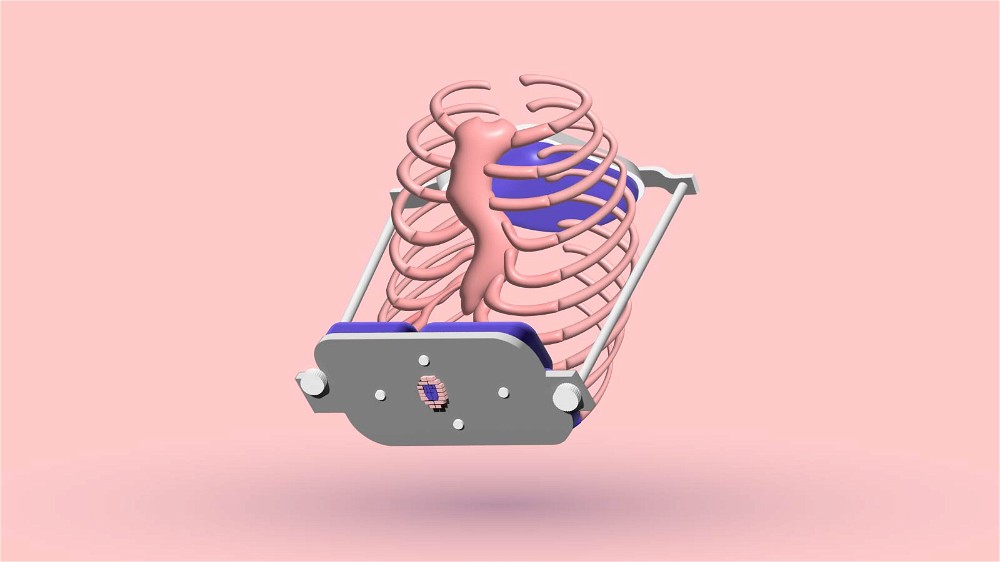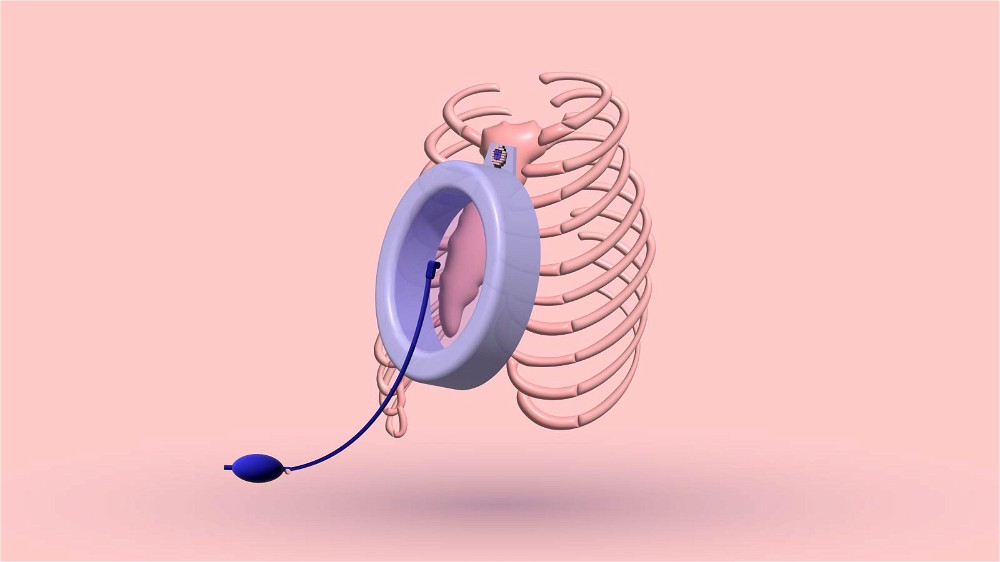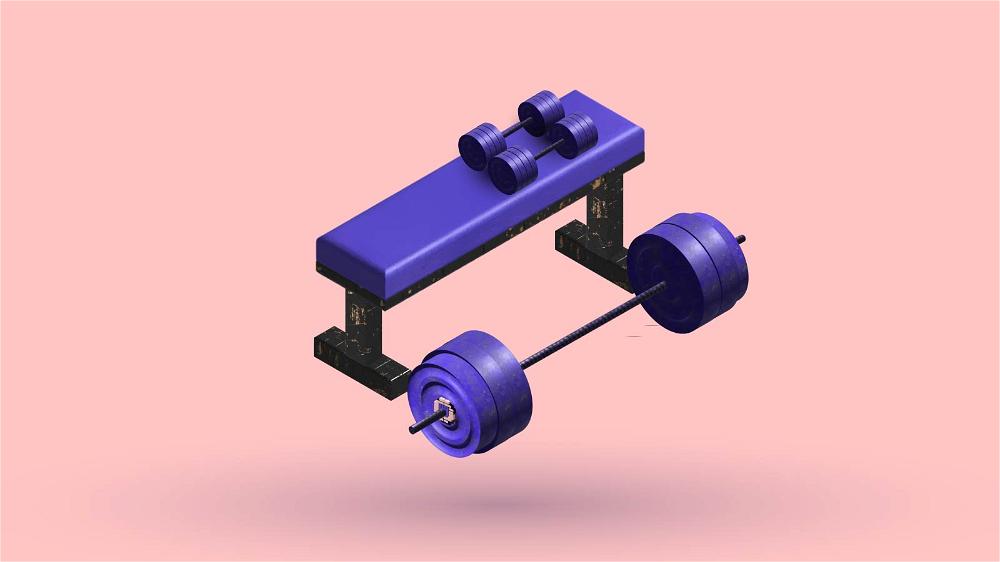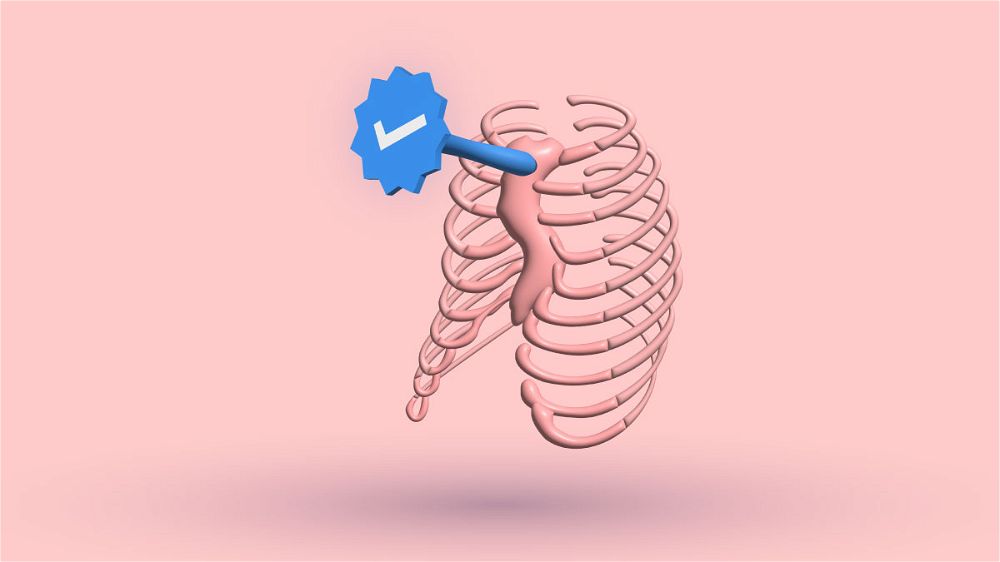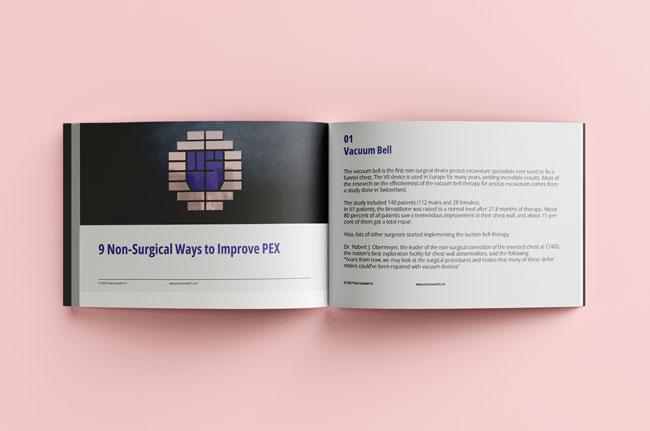Pectus excavatum, also known as funnel chest, is a condition where the breastbone of the sufferer grows inward. The breastbone and rib cage grow abnormally, resulting in a dent in the anterior thoracic wall. Pectus excavatum is the leading cause of rib flare.
If the condition is severe, it can look like the middle of the chest is scooped out, creating a deep hole. The concave sternum can even be visible after birth. In 90% of all cases, it is detected within the first year of life.
However, the disorder mainly worsens after the puberty growth spurt. That is when the posture in adolescence worsens because of the body's rapid development.
Things You Should Know

The deformity mainly affects teenagers, leading to a decrease in self-confidence and social anxiety. The adverse psychological effects caused by the concave chest condition make teenagers avoid doing any tasks that show their chest.
On top of that, pectus excavatum can cause heart and breathing function problems while running. This causes shortness of breath and sharp pain in the chest and back area. Doctors don't know what causes pectus excavatum.
For now, you should know that pectus excavatum is treatable both surgically and non-surgically. Both methods are effective. It will be up to you to decide which path you will take. In the text below, I will discuss the advantages and disadvantages of both methods.
Do You Have Pectus Excavatum?

There is an obvious way to determine whether you have pectus excavatum. However, the severity of the deformity is always different.
That makes sufferers with a slight abnormality in the chest wonder whether they have it. If your chest is dented slightly and you have some of the following symptoms, you suffer from pectus excavatum.
The main symptom of pectus excavatum is a sunken appearance of the breastbone. The depth of hollowness differs from person to person. It starts to get worse during puberty and continues to worsen during adulthood.
Protruding Ribs

Another common symptom is a flare in the lower area of the ribs. Most doctors claim that protruding of the left rib is more common than the right rib counterpart.
The rib flare deformity causes a lack of equality in the diaphragm, leading to chest and heart pain. Uneven chest musculature is also an excellent indicator for pectus excavatum.
Irregular Heartbeat
In minor cases of pectus excavatum, heart functioning is normal. Nevertheless, the condition can relocate or rotate the positioning of the heart. This results in a rapid and irregular heartbeat.
If the disorder is severe, there can be compression to the right atrium, and mitral valve prolapse can occur, which leads to a reduction in physical abilities.
Chest and Back Pain
Most pectus excavatum sufferers experience ache in the chest and back area. The pain is usually present during the day, especially during physical activity. This may lead to insomnia.
Pectus excavatum sufferers are prone to recurrent lung infections, painful coughing, or wheezing.
How Common Is It?

Pectus excavatum is more frequent in males than in females. The ratio is 3:1 in favor of males. It is projected to occur in one of every 300-400 births. The indented chest is the most common congenital chest wall deformity (90% of all chest structure deformities are diagnosed as pectus excavatum).
It is followed by pectus carinatum diagnoses (7% of all chest deformities). That is where the breastbone is pushed outward. It is also known as a pigeon chest.
Is It a Disease?

Pectus excavatum is not a disease. You can't get "infected" with pectus excavatum by being coughed on, sneezed on, touched, or kissed by someone who suffers from it. It is a genetic structural deformity of the anterior thoracic chest wall.
On most occasions, it is present at birth in newborns and progresses during puberty. Recent studies concluded that pectus excavatum might point to hereditary connective tissue illnesses like Marfan syndrome.
I've seen a lot of content online, mainly on Q&A sites, where people categorize pectus excavatum as a disease, but every single scientific article about pectus excavatum classifies it as deformity.
How to Fix It
- Surgically
- Non-Surgically
Surgical Repair
The first option is surgery. That elective procedure usually requires insurance approval in the United States. The operation is generally done in the adolescent years when the person is in puberty. That's when a massive growth spurt hits every kid and can worsen the intended chest deformity if left untreated.
Pectus excavatum surgery for adults is possible, but it isn't as effective as doing it in the teenage years. That is because the anterior chest wall of the adult patient is "stiffer" than younger patients. Adults are more prone to complications during and after the operation.
Also, there is a high chance of recurrence of the malformation after the surgery. There are two types of pectus excavatum surgery.
Ravitch Procedure

The first one is an open repair Ravitch procedure. Surgeons make a horizontal cut along the middle of the patient's chest. The cut is done to remove the abnormal ribcage costal cartilage. The cartilage is lined to a healthy state, making the breastbone reach a normal position.
If the pectus excavatum condition is severe, a break in the breastbone is made to help it get back in a front position. In addition to removing the abnormal cartilage and making the break, an impermanent bar is placed to keep the breastbone in the wanted area.
The surgeon does the Ravitch procedure in about 6-8 hours on average.
NUSS PROCEDURE

The second one is the minimally invasive Nuss procedure. The surgeon does this by placing a metal pectus bar underneath the sternum. The bar is modified and cut precisely to fit each patient.
The surgeon inserts it into the patient's body by making minor cuts under each arm. An endoscope is used to monitor the vital internal organs of the patient, especially the heart. That is done to prevent any cuts to them that can lead to excessive blood loss, which can be deadly.
The pectus bar goes over the rib cage and under the breastbone, pushing it to the required normal position. The surgeon secures its ends to the chest wall with screws. The Nuss procedure takes, on average, about 4 hours to be done by surgeons.
Every patient undergoing this procedure must carry the titanium bar underneath the sternum for 2-3 years. Many physical activities need to be limited by the patient during this period.
Recovery still requires a few weeks after pectus bar removal. Both surgeries are done under general anesthesia and require a post-operation hospital stay of seven days. Most patients are good candidates for the Nuss procedure.
However, the choice of surgery is usually made by the surgeon, depending on the patient's dent severity and age.
Non-Surgically
Back in the day, the only way to correct pectus excavatum was through surgery. In the last few years, there has been an increase in scientific evidence that proves the effectiveness of converting the concave chest with non-surgical methods.
I had a severe case of funnel chest and flared ribs. I improved them in a year by consistently performing a proven physical therapy routine, wearing posture braces, and using a vacuum bell.
If you combine these three, your pectus excavatum condition will significantly improve in a year. Pectus excavatum surgery for adults is possible, but it isn't as effective as doing it in the teenage years.
That is because the anterior chest wall of the adult patient is "stiffer" than younger patients.
Physical Therapy
Physical therapy consists of performing the most excellent pectus excavatum exercises and stretching the tight muscles that cause imbalances and worsen your posture.
Performing deep breathing will also help you lift the sternum.
Pectus Excavatum Exercises

There are two types of exercises for sunken chest you can do. Bodybuilding and bodyweight exercises. Both are fantastic ways to build muscle mass in your upper body.
Gaining mass and muscle is a great way to improve your body's appearance. If you want to build mass most effectively, I highly recommend you perform bodybuilding exercises.
Some of them are the bench press, dumbbell flyes, pullovers, weighted pull-ups, deadlifts, etc. These are a few of the most effective exercises used by most bodybuilders with pectus excavatum.
The purpose of the exercises is to build muscle in the areas where the chest is caved. The results will make the dent in the chest appear not as deep as it is.
Look at the athletes that participate in calisthenics. They aren't as huge as bodybuilders, but they are incredibly lean and muscular. If you only do pushups and pull-ups, you'll need a long time before you see any improvement in the chest wall appearance.

However, combining bodyweight and weighted exercises yields the most significant and fastest results.
Working out will help you reduce social anxiety and depression when you start to approve the looks of your body. You will finally take off your shirt at the pool party, finally impressing the members of the opposite sex.
Yoga

Yoga is the staple of the 8-week pectus excavatum workout template I designed and used. Just like swimming, it works out a lot of muscles at the same time without putting stress on your joints.
It will help you eliminate muscular imbalances that worsen your pectus excavatum condition in the long run. If you perform yoga three times a week for a month, you'll notice how you walk more upright.
Yoga and braces are hands-down the best way to improve your posture. As you read above, poor posture is the most common symptom in all patients suffering from pectus excavatum.
If you improve your posture, you're on a great path to bettering your condition.
Swimming

I am also a massive fan of swimming to better the funnel chest condition. It is a low-impact type of workout that is easy on your joints. If done correctly, it works 60 muscles at the same time.
Swimming will improve your posture, strengthen the weak back musculature, and develop the pectoral muscles that will make your inverted chest much less noticeable. To improve the condition through physical therapy, you need a set of weights, a pull-up bar, a dip station, and a yoga mat.
If you purchase the required exercise equipment, you can improve the condition from the comfort of your house. You won't even need to buy a gym membership.
Deep Breathing

If the pectus excavatum is severe, the patient will have a limited capacity for physical exercises and shallow breathing patterns. The poor posture will cause tightness in the frontal musculature related to effective breathing.
If you stretch the tight frontal musculature of your body, you will notice how your breath gets more in-depth. That will make you feel more energized during the day.
Also, deep breathing can help you pull the whole chest out. I am a massive fan of doing bioenergetics daily. Since I've done them, my breath has no longer been shallow, and I feel much more energized.
I can think that the tightness of my frontal musculature is gone. Check out this video of Elliott Hulse showing you how to do bioenergetics correctly.
Corrective Bracing

Wearing correct pectus excavatum braces daily will positively impact your caved-in chest. I wore the LaceIT pectus excavatum brace for about a year. It provided enough pressure on my abnormal chest bone structure to reshape it while being comfortable on my skin.
It is hands-down the most magnificent brace you can wear for treating a deformity. I combined wearing that with physical therapy. My condition improved so much that my doctor was impressed by the effectiveness of the non-surgical method.
Click the following link for a detailed review of the top 5 pectus excavatum braces you can purchase in 2019. The Neo G concave chest and LaceIT brace are the most popular braces.
I reviewed them based on comfort, external pressure, breathability, and adjustability. These factors play a considerable role in the effectiveness of the brace in improving pectus excavatum.
I also wrote about when you should wear the brace, when you shouldn't, how long to wear it, before and after pictures, and much more.
Click here for scientific evidence of brace effectiveness

There is scientific evidence of the efficacy of using orthoses (braces) in improving pectus excavatum. In a 32-year-long study done by orthopedist Sydney Haje, and his son Davi Haje, data for 4012 patients who suffered from pectus deformities was collected.
They concluded that the anterior chest wall of patients is flexible and can be remodeled by external forces provided by braces. It is easier to repair the bone structure of younger patients than adults because their chest wall is more flexible.
However, the study showed that bracing could reshape the adult's chest wall successfully. They just needed to wear the brace for longer during the day.
This Dynamic Remodeling method, consisting of wearing braces and doing pectus excavatum exercises, is based on Nicolas Andry's and Julius Wolff's studies.
They concluded that the bones in a healthy person would constantly reshape to the external pressure put upon them. The orthopedic approach to pectus deformities works magnificently.
Vacuum Bell Therapy
The vacuum bell is a rubber or cup-designed device that links to a pump. The pump draws air from the invention when you put the device over the dent.
A vacuum pulls the chest and sternum back to the correct position. After prolonged use, the chest will return to proper positioning.
The vacuum bell therapy is exceptionally safe in treating pectus excavatum without surgery. Over the years, there were just a few complication reports. The reports serve as additional proof of the safety.
how to use vacuum bell

The success of the vacuum bell therapy hugely depends on patient motivation. It would be best to use it consistently, even when you don't feel like doing that. Discipline is a hidden ingredient in the success of vacuum bell therapy.
The vacuum bell is extremely simple, and kids can even use it independently. If your kid is under ten years of age, I highly recommend you provide help. You can also request instructions for using the vacuum bell at the clinic.
Wearing the vacuum bell isn't the most comfortable thing in the world. At first, it may be slightly painful, but you'll get used to that feeling in about a week. Your child won't refuse to wear it.
There is a high chance that it will even embrace it because it seems fun. We all sucked a part of our skin with the vacuum cleaner. The feeling is very similar. First, I recommend you wear the vacuum bell for about 30 minutes twice daily.
After one month of use, you can increase up to 2 hours. Place the vacuum bell on the most profound dent in your chest. In about 3-4 months, expect to notice a vast improvement in your chest wall appearance.
Aim to wear it for nearly a year, daily. It will be hard to notice a difference if you see yourself in the mirror daily. That is why I recommend you take a before and after picture to see the development over the months.
Advantages of Non-Surgical Therapy

Compared to surgical procedures, there are many advantages of choosing the non-surgical treatment for improving a concave chest. Also, there is much less of a psychological toll on the patient. Pectus excavatum surgery can be taxing psychologically.
For three long years, the thought of having a titanium bar underneath the sternum can be devastating.
Surgery Will Cause a Scar
On top of that, the Ravitch procedure will leave a substantial horizontal scar across your chest. On some occasions, the scar will look far worse and will draw more attention than having a caved-in chest.
Lots of patients regretted undergoing a Nuss or Ravitch procedure. That isn't the case when you treat the condition non-surgically.
Give the Non-Surgical Therapy a Chance
Give yourself a year. Try to do everything I tell you to do. Perform the most excellent exercises for funnel chest, wear a brace, use a vacuum bell, go swimming, and perform deep breaths.
I guarantee you will be glad you didn't undergo surgery in a year. You can still take the surgery if the non-surgical way of improving pectus excavatum fails.
Cheaper than surgery
Another benefit of non-surgical treatment is that it is far cheaper. You don't need to pay thousands of dollars for surgery, hospital stay, and medications.
The surgery cost for adults in the United States is very high without insurance. The only thing that separates success and failure is discipline. You need a lot of discipline if you choose to improve the deformity non-surgically.
Stay dedicated to the daily schedule, and do everything you're supposed to, even when you don't feel like doing that. Honestly, it only takes about 30-45 minutes in your day to do all the physical therapy exercises.
Also, wear a brace throughout the day, and you'll be fine.
What Doctor Is Responsible for Pectus Excavatum

Most people assume that pectus excavatum patients need to be treated by orthopedic surgeons. As you already know, this is a bone deformity condition.
People who want to treat the condition non-surgically usually look for Orthopedic offices. It is very logical to think that, but sometimes the Pediatric Orthopedics offices aren't familiar with pectus excavatum because they don't treat it.
That is the problem with the medical system in the United States. There is a piece of clear scientific evidence that proves pectus excavatum can be treated using Orthopedic principles.
They neglect that fact and want the pectus excavatum sufferers to be treated only by surgery. I honestly think that is done because the medical system cannot profit as much from non-surgical treatment for patients.
The people that treat pectus excavatum are called Upper Thoracic Specialists.
What Does Upper Thoracic Specialist Treat
Upper Thoracic surgeons usually treat patients that had a heart attack. However, the rib cage isn't just a set of bones. These surgeons are specialized to deal with damage to the rib cage's internal organs.
If the pectus excavatum condition is severe, it may press and damage the organs in that region. The doctor you need to look for is the Upper Thoracic Surgeon.
Even though the title is "surgeon," it doesn't mean you'll need surgery. This surgeon treats both pectus excavatum and carinatum conditions.
Does it Get Worse with Age?

Pectus excavatum doesn't go away on its own. In most occasions, it even gets worse as you age. It often worsens because of weak musculature, improper posture, and shallow breathing.
You must stop it from getting worse because it can press and dislocate the positioning of your heart and lungs.
Can It Shorten Lifespan?
The pectus excavatum worsening will lessen their working capacities, causing respiratory infections and heart diseases. The life expectancy of pectus excavatum sufferers is much shorter than people without it. There is a high possibility it will cause problems in later life.
Pectus excavatum sufferers underestimate how many problems can be caused by this condition. If you remain still, the dent will get more in-depth, and your confidence will even be shattered. That will make you an ideal candidate for surgery.
Please Don't Wait
Waiting is a mistake that many pectus excavatum sufferers make. They aren't aware that pectus excavatum gets worse day by day. It is delusional to think that pectus excavatum goes away with time.
A scientific article discusses how a healthy 59-year-old male started having constant aches in the body, fatigue, breathing problems, and heart complications.
This was all caused by not treating his pectus excavatum condition when he was younger. After undergoing a Ravitch procedure, all these problems disappeared.
Changing your lifestyle to be congruent around the pectus excavatum condition is essential. You'll reap a lot of psychological and physical benefits if you opt to treat the malformation non-surgically.
How to Determine the Severity
Determining the severity of pectus excavatum can be done with two methods. The Haller index is still the most used method; however, the Sternum Index method has shown to be a great alternative.
STERNUM INDEX

Radiologists can determine pectus excavatum severity with a revolutionary method called Sternum Index (SI). It is used to reduce radioactive exposure by the Haller Index (HI) method preoperatively.
The Sternum Index (SI) is calculated based on the anteroposterior diameter of the chest dent, from the breastbone to the spine, divided by the patient's height.
Sternum Index =
anterioposterior diameter of the chest hole / the sufferer’s height x 100
Recent studies have compared the results received by the Sternum Index and Haller Index. One hundred nine patients were a part of the study. After the studies, there was minimal variation between the Haller Index and Sternum Index methods.
The studies showed a good relationship between the HI and SI methods. The study concluded that the Sternum Index is a fantastic alternative to the Haller Index in determining the severity of pectus excavatum without any radiation exposure.
Pectus excavatum surgery for adults is possible, but it isn't as effective as doing it in the teenage years. That is because the anterior chest wall of the adult patient is "stiffer" than younger patients.
HALLER INDEX
The Haller Index (HI), also known as the pectus index, is the most commonly used method to determine the harshness of the pectus excavatum. It is a mathematical method that evaluates and describes the chest wall structure on a CT scan of the thorax. HI is used for preoperative and postoperative estimation.
Haller Index =
distance of the inside ribs at the lower third of the breastbone / distance between the sternal notch and vertebral column
Recent scientific studies show that simple chest x-rays are as helpful as CT scans for calculating the Haller Index. Some radiologists started implementing CXR instead of CT scans. A standard CT scan is used if the pectus excavatum deformity looks severe.
Specific Haller Index values determine how severe the pectus excavatum is.
- Standard chest < 2.0 HI.
- Slight Pectus Excavatum < 2.0 - 3.2 HI
- Moderate (Mild) Pectoralis Excavatum < 3.2 - 3.5 HI.
- Serious Pectus Excavatum > 3.5 HI
Surgeons must schedule pectus excavatum surgery if the Haller Index is equivalent to or higher than 3.3. If the HI is that high, it will cause respiratory and heart problems that you cannot treat with conservative non-surgical therapy.
However, the Haller Index of 3.3 is very severe, and you probably have undergone surgery in your childhood to improve it. Otherwise, non-surgical treatment is still the best solution for bettering pectus excavatum.
Pectus excavatum surgery for adults is possible, but it isn't as effective as doing it in the teenage years. That is because the anterior chest wall of the adult patient is "stiffer" than younger patients.
How to Deal With Pectus Excavatum

The unnatural look of the chest is the main reason sufferers want to hide their pectus excavatum condition from the world. I've seen people with far worse sunken deformity than others accept their flaws and even embrace their body appearance.
They live more freely and take off their shirts at pool parties.
Simple Tip to Become More Confident

When I feel self-conscious, I always look up to celebrities and athletes with pectus excavatum. They are the epitome of confidence because they decide to show their imperfect bodies to the whole world.
Even though they were insecure about it in the past, they decided to crush that fear and live freely after.
Don't Hide It
There is no reason for you to hide your pectus excavatum disorder. Every single person in the world is insecure about something in their appearance. Don't be surprised that some supermodels hate how they look.
Victoria's Secret supermodel Miranda Kerr said that models are some of the most insecure people in the globe.
Stop Bashing Yourself
Don't be harsh on yourself if you suffer from pectus excavatum. You're not the only insecure person about how your body looks. Hiding pectus excavatum is the easiest thing you can do.
All you need to do is put a shirt on, never take it off at the beach and never turn on the lights during intimate moments. However, that is not the healthiest way you can live life. The thought of having a significant flaw will always be in your mind.
Two ways to Deal With It
When the thought of "How to hide my horrible dent in my chest" occupies your mind, there are two things to do; Embrace your uniqueness and start the non-surgical treatment. The pectus excavatum condition will be less evident if you build the inner pectoralis muscles in the chest.
Don't focus on that muscle only. Build the pectoralis muscles, add mass to your upper body, and improve your posture. That is how the pectus excavatum becomes much less noticeable.





